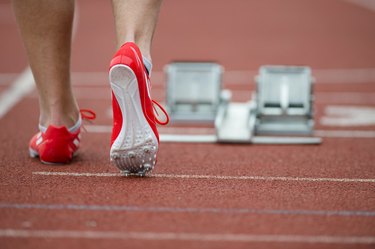
The only difference among metal spikes on the bottom of a sprinter's shoes used to be the length. Now, spikes are available in shapes and lengths specific to certain distances, events and types of track surfaces. Deciding on which type of track spike to use can improve results and influence training methods. Especially important is guidance for adolescents. Those still growing need to get the right spike and create good habits and form that will last a lifetime.
Pyramid Spikes
Video of the Day
Traditional spikes were developed by the founder of the shoe company that turned into Reebok, Joseph William Foster, around 1890. The Adidas shoe company did further refinement in the 1930s, and today's spikes are generally that shape. Pyramid spikes come in different lengths. The most common is 1/4 inch and is used on synthetic indoor and outdoor tracks. The USA Track & Field Association allows only this type of spike at its sanctioned meets.
Video of the Day
Needle Spikes
Spikes with a sharp needle tip are called needle spikes. These are mostly sold in 3/16-inch length and give a good grip in rainy and damp track surfaces. Use them with caution because they can really sink into the track, requiring effort to get them out again. Lighter-weight runners generally do better with needle spikes. Heavier runners hitting the ground with more force do not need to dig in as much. Longer needle spikes, from 1/4 inch to 3/8 inch, work well on an outdoor cinder track as they penetrate the surface layer and dig into the base firmly.
Other Considerations
Beginning sprinters are better off using pyramid spikes until very good form is achieved because it's possible to scratch the opposite leg with with spikes if you overpronate on a stride. Needle spikes are used mostly for running on all-weather tracks that have a springy surface. These spikes are under the forefoot of the shoe because short sprints are run entirely on the toes. This allows optimal forward motion, with the spikes keeping the foot pointed forward.
Heel Cushioning
For any distance longer than a few hundred meters or for beginning runners, it is better to use a shoe with pyramid spikes under the forefoot and a heel cushioned with padding under the heel cup. This is a good compromise between toe grip and heel strike support. For example, during a 10,000-meter race indoors and outdoors, a runner's heel strikes and the toe follows. Pyramid spikes help maintain a forward foot direction.